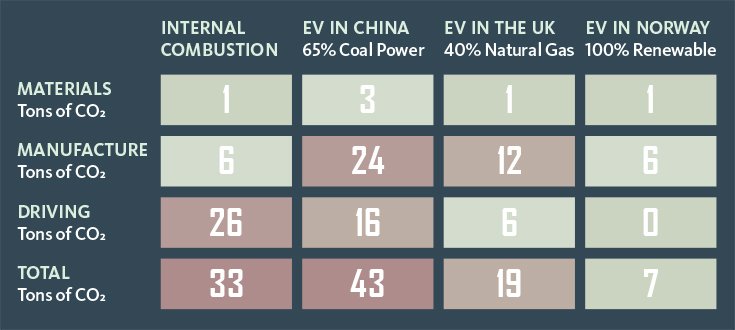Charged
Far from a new invention, electric cars once made up a third of vehicles on the roads in the initial days of the automobile.1 In fact, Henry Ford and Thomas Edison teamed up to build their own electric vehicles in the early 1900s.
In a 1914 New York Times article, Ford said, “Within a year, I hope, we shall begin the manufacture of an electric automobile. . . . The fact is that Mr. Edison and I have been working for some years on an electric automobile which would be cheap and practicable. We are satisfied now that the way is clear to success.”
But Ford’s electric car never quite took off for the same reasons that people often put on the brakes about buying an electric car today: range and affordability. Compared to gasoline powered cars, the electric car couldn’t keep pace, so the automotive industry—including Ford’s company—invested in the four-stroke gasoline engine.
In the last few decades, electric vehicles (EVs) have been making a comeback thanks to longer-lasting lithium batteries and a strong political push for EVs, which are promoted as “clean” and “essential for saving the environment.”
Most Western countries hold the worldview that climate change is causing extreme weather events and that urgent policies must be adopted to counter the rising levels of carbon dioxide (CO2). Environmentalists and lawmakers point to gasoline-powered vehicles as public enemy number one. The New York Times claims, “Transportation is the nation’s top source of planet-warming greenhouse-gas emissions.”2 The way to cut back on those emissions? Electric cars.
Though much of the US is still warming up to the idea of a plug over a pump, some states have already embraced EVs—and some don’t have a choice. By 2035, New York and California expect to sell their last gas-powered cars. Regarding tail pipes, California governor Gavin Newsom claimed, “Our kids are going to act like it’s a rotary phone.” And to prove the government’s commitment to clean transportation, in 2022, US President Biden passed the Inflation Reduction Act, offering tax credits up to $7,500 to Americans buying new EVs.
But many question the viability of entire states and the nation mandating the switch to EVs. Will the charging infrastructure be ready? What about the vehicles’ limited range for long distance travel? How about the environmental harm caused by lithium battery production? Is it the government’s place to mandate what should be a personal choice?
EVs are parked at the center of this charged issue. But when you look under the hood of the embroiled EV dispute, you’ll find . . . a machine. Neither moral nor immoral, an electric car is merely a group of moving parts. Unfortunately, faulty worldviews adorn these machines like gaudy bumper stickers.
As Christians, we are called to wisely steward creation and to love others. Our choices affect our neighbors down the road and across the globe—including our choice of what vehicle to drive. So when we’re told that EVs are the healthiest option, we need to look at the worldview and data so we can discern how to be good stewards of the Creator’s earth and our fellow humans.
The Pollution Perspective
Since zero emissions is one of the EV’s premier selling points, we must understand emissions and where they come from.
Gasoline cars produce pollutants (emissions) such as hydrocarbons, formaldehyde, and carbon monoxide by burning fuel. The amount of emissions from an individual car is now relatively low because technologies, such as catalytic converters, break down most of the pollutants into water and CO2. However, with a large number of cars in a small area like a city, the emissions can build up, leading to respiratory disease, heart disease, and cancer.
It’s important to recognize, however, that CO2 itself is not a pollutant but an important natural component of air along with oxygen and nitrogen. In fact, CO2 is vital for life. The real concern in the climate change conversation involves the amount of human-induced CO2 being released in the environment and the possibility that it is raising the earth’s temperature.
Scientists, including creation scientists, agree that earth’s temperature has been rising for the past few centuries following the little ice age around AD 1300–1850. It’s also indisputable that CO2 has been rising for decades. However, although CO2 is a greenhouse gas capable of raising the temperature, no absolute proof points to a correlation between rising temperature and CO2. Furthermore, only a fraction of the total amount of CO2 in the atmosphere is caused by human industry.3
Climatologists rely on computer-generated models to estimate the rise in temperature in response to CO2. But these models often inflate the warming trends, providing a faulty basis for making policies or future climate predictions.
Secular climatologists interpret the climate data using evolutionary assumptions that man is in control of the unpredictable environment.
In contrast, God has revealed that he created the world specifically to accommodate life (Genesis 1; Isaiah 45:18) and promises that life will continue here on earth until Jesus returns (Genesis 8:22). However, we expect to experience fluctuating temperatures and weather patterns as the atmosphere continues settling after the catastrophic global flood of Noah’s day 4,500 years ago (Genesis 6–9).
The frantic conversation around the supposed climate-saving capabilities of electric cars is driven by a worldview that doesn’t acknowledge God’s role in maintaining the planet. With that perspective in mind, we can inspect the raw advantages and disadvantages of EVs before going to the car lot.
Advantages of EVs
No Emissions
Without an engine burning fuel, EVs release virtually zero emissions while running. Electric vehicles are good for locations with very dense pollution such as inner cities. Some major cities such as New Delhi have so many industries and gasoline vehicles that the pollution levels cause problems such as smog, which is unhealthy to breathe and blocks out light. Electric cars can be an effective way of helping cities to reduce pollution, improve air quality, and save lives. One study reported that a significantly higher use of EVs by 2050 would improve air quality, potentially preventing up to 1,163 premature deaths in Los Angeles and saving over $12 billion in health costs. The same study reported similar potential results in other large US cities.4
Low-Speed Efficiency and Regenerative Braking
EVs are also good for congested traffic such as in busy cities. Whereas a gasoline car has poor efficiency at very low speeds, an electric car is highly efficient with the ability to perform regenerative braking by using the force of braking to recharge the batteries. This is ideal for the stop-and-start type of driving in cities.
Fewer Parts
An EV’s drivetrain has fewer than around 20 moving parts as opposed to over a thousand in the drivetrain that propels an average gas vehicle down the road. Though owners still need to oversee maintenance such as changing windshield wipers and air filters, the service fees will be low with no need to change oil or replace parts such as spark plugs or belts.
Lower Running Cost
EVs generally have lower per-mile running costs because recharging with electricity is usually cheaper than the cost of gasoline. An average American family spends around $2,660 on gas annually per car,5 while charging the average EV costs only around $672 a year.6 However, electricity is not always cheaper than gasoline. In some European countries, like Great Britain, the cost of charging EVs has recently become more expensive than buying gasoline because the Russia-Ukraine war has caused electricity prices to soar in Europe.
Disadvantages of EVs
Because modern EVs are in the relatively early years of development, the industry faces several serious challenges (by no means covered comprehensively in this article). Some of these challenges may be resolved through future improvements in technology.
High Emissions and Pollution During Production
EV battery production requires huge amounts of energy that can lead to significant CO2 emissions and pollution. Extracting battery materials, such as lithium and cobalt, requires energy from CO2-emitting fossil fuels. Processing battery materials at temperatures around 1,832ºF (1,000ºC) also relies on fossil fuels.
According to the MIT website, while making an 80 kWh (kilowatt per hour) lithium battery for the Tesla Model 3, the process would release between 2.5–16 metric tons of emissions. One ton of CO2 is about the amount that a typical gas car releases over 2,500 miles. When you do the math, those emissions add up. While emissions are lower in battery production based in Europe and the US (due to lower reliance on coal-fired power stations), most battery materials are currently refined in China, which has a much higher emissions rate.7
Mining battery materials requires large amounts of chemicals and leaves behind contaminants and toxic waste. In fact, metal mining leaves about 100 billion tons of waste. In 2018, the mining industry created 3.6 billion metric tons of CO2—10% of the world’s human-induced greenhouse gas emissions.8 For the world to fully convert to EVs, mining of these materials must vastly increase. A recent International Energy Agency (IEA) report estimated that to reach the world’s 2050 target of net-zero carbon emissions, the demand for minerals like lithium, copper, and nickel will have to increase sixfold.9 While EVs might reduce emissions in Europe and America, EV production significantly pollutes countries such as Congo, Argentina, and Canada that mine battery materials.
Recycling batteries could potentially relieve some of the problems of battery production. However, few spent lithium batteries are currently available to recycle, since EVs have been on the market for only around 20 years. Battery recycling is difficult because of a battery’s complex circuits and systems. But research is ramping up for more efficient recycling processes. In fact, in 2019, the US Department of Energy created the ReCell Center, a research center devoted to developing a cost-effective recycling process for lithium batteries.
Low Travel Range and Battery Life
Despite recent improvements, EVs still offer a relatively low range, giving some buyers “range anxiety.” In 2021, the average EV range was a little over 200 miles per charge with an average recharge time of 3–8 hours on a 240-volt charger and 11–20 hours on a 120v home EV charger. The average gas car takes only a few minutes to refill and has a range of around 413 miles (664 km)—double the average EV range.10 But these numbers only account for a new battery’s range. Though it depends on the car and a host of other factors, EV batteries generally degrade by 2–3% a year.11
Replacing EV batteries can cost up to $20,000, though the average price seems to fall between $2,000 and $10,000. To offset that cost, EV manufacturers often offer new car buyers an 8–10-year warranty to cover batteries that no longer hold a charge or when their charging capabilities drop below a certain percentage.
Small Charging Infrastructure
Homeowners can purchase chargers to keep in their garage, but for the millions of Americans who live in apartments or use street parking, charging their EVs can be challenging.
For gas-powered car owners, a filling station waits on just about every corner. But EV owners don’t have as ready access to their electrical needs, especially those living in remote areas. Currently, around 140,000 public ports allow EV owners to charge across the country. But the Bipartisan Infrastructure Law, which passed in 2021, devoted $7.5 billion to building the US’s EV-charging infrastructure, with a goal of installing a nationwide network of 500,000 public charging stations by 2030.12 However, if the nation meets the federal target that half of all new vehicles be zero-emissions by 2030, the US would need 1.2 million public charging stations to meet the demand.13
With this projected rise in EV charging needs, people fear that the nation’s power grid will not be able to sustain the extra requirements, particularly in hot weather. In September of 2022, while facing triple digit temperatures, California asked EV owners to avoid charging their vehicles between 4 and 9 p.m. to allow for the power demand of people trying to keep cool. A similar message went out in Texas, highlighting the dire need to stabilize the power grid before implementing sweeping policies that would likely have life-altering consequences.
Future advancements in battery technology may bring the EV cost down, but for now, most EVs lie outside the price range most Americans are willing to pay for their ride.
Steep Price
According to Kelley Blue Book, the average cost to drive a new gas-powered vehicle off the lot is over $48,000, while a new EV costs 35% more at an average of over $65,000.15 This price disparity has a long history. In 1912, a gas-powered car cost $650 while an electric car went for $1,750.16
The price of EVs isn’t decreasing. In fact, a recent report revealed that the cost of EVs increased by over 54% from 2021 while gas-powered cars only rose 10%.17 The sharp rise in price for both options partially had to do with a computer chip shortage and drop in inventory caused by the COVID-19 pandemic. Future advancements in battery technology may bring the EV cost down, but for now, most EVs lie outside the price range most Americans are willing to pay for their ride.
With the lower maintenance and fuel costs, some estimates show that EVs come out cheaper, even with a higher sticker price. Of course, be sure to do your own calculations based on your needs and desires.
Safety
Lithium batteries pose a danger because they’re composed of tight electrodes prone to short-circuit sparking, surrounded by flammable liquid electrolyte. Lithium-caused fires burn hotter and faster than gas-fueled fires and can be difficult to extinguish. Even worse, the fire can reignite days later.
Still, lithium fires are relatively rare in fully electric vehicles. According to one report, EV batteries have .03% chance of catching fire compared to a gas engine’s 1.5% chance.18 Researchers are addressing the safety concerns. Recently, several electric car producers shifted their battery chemistry to a more stable design.
Comparing Emissions
Emissions are the chief factor in the argument for or against EVs. But the power grid behind the manufacturing and charging of EVs completely changes the amount of emissions.

*Based on estimated numbers from a gasoline Ford Focus vs Ford Focus EV with 10 years of use at 10,000 miles per year and 15% regenerative braking.14
EV Checklist
When evaluating whether an electric vehicle is for you, consider these factors.
Driving Habits
Consider the distance you typically drive. EVs are an excellent choice for low-range, inner city use with lots of starts and stops.Range
Make sure the battery range will meet your needs for longer trips.Charging
Investigate the charging network available in your area to support your energy needs. Also consider if your housing situation would allow at-home charging.Maintenance
Compared to traditional vehicles, EVs have fewer moving parts, leading to lower maintenance costs.Incentives
Check for any government incentives available to offset the cost of purchasing an EV.Budget
EV purchasing costs are often higher than gasoline vehicles, but lower fuel and maintenance costs can offset the higher upfront price over time.
Good Stewardship
Because nothing in our fallen world is perfect, EVs have advantages and drawbacks, much like their gas-powered counterparts. Whichever kind of vehicle we decide to buy, we must choose wisely based on our finances and lifestyle needs.
But we must be aware that the message that EVs are a zero emissions option is very misleading. EVs won’t be spewing emissions while idling at a red light, but the processes that make, charge, and ship the cars rely on fossil fuels and release emissions. To give a more accurate reflection of the environmental impact, politicians should really be referring to “zero emissions during use” and the amount of CO2 emissions introduced into the environment when mining lithium and cobalt for EV batteries.
We also need to inspect the worldview shaping the mandates for EVs. In a world of finite resources, it’s wise to minimize energy consumption and reduce pollution, but we need to vote for lawmakers who will hold in tension the need to steward the earth and to make reasonable policies based on accurate data and the way their policies will affect people’s lives. Rather than banning gasoline cars, governments would do better to set tough emission targets and let manufacturers develop the best gas and EV car designs that meet those targets. Customers can then choose how to best spend their money.
God designed our earth and its climate and promises to sustain our world until he creates the new heavens and new earth (Genesis 8:22). As we trust in his care, we can use data, not panic, to discern how best to move forward—whether there’s a V-8 engine or a lithium battery under our hood.
The Road Ahead
Electric vehicles present some significant challenges. Arguably, the dominion mandate compels us to persist against failure and address obstacles using our God-given ingenuity and creativity.
Over the last 135 years, gas-powered cars have undergone many refinements in safety, comfort, efficiency, and design (including coil spring suspension in 1934, keys in 1949, power steering in 1951, seat belts in 1959, antilock brakes in 1971, catalytic converters in 1973, and airbags in 1998). EVs will experience similar refinements as technology improves.
Scientific and technological advances don’t exist in a vacuum. As the demand for electric cars intensifies, research will likely yield more effective battery technology, influencing the safety and longevity of batteries and technologies in our everyday lives.
Answers Magazine
April–June 2023
Gap theorists insert millions of years between the first two verses of Genesis. But what really lurks in that gap?
Browse Issue SubscribeFootnotes
- "The History of the Electric Car,” September 24, 2015, Energy.gov, https://www.energy.gov/articles/history-electric-car#:~:text=By%201900%2C%20electric%20cars%20were,continued%20to%20show%20strong%20sales.
- Coral Davenport, Lisa Friedman, and Brad Plumer, “California to Ban the Sale of New Gasoline Cars,” New York Times, August 24, 2022, https://www.nytimes.com/2022/08/24/climate/california-gas-cars-emissions.html
- For further reading, see https://answersingenesis.org/environmental-science/climate-change/globe-is-warming-but-its-not-your-fault/ and https://answersingenesis.org/environmental-science/climate-change/what-scientists-ignore-about-climate-change/.
- Shuai Pan, Wendi Yu, Lewis M. Fulton, Jia Jung, Yunsoo Choi, and H. Oliver Gao, "Impacts of the large-scale use of passenger electric vehicles on public health in 30 US. metropolitan areas," Science Direct, https://www.sciencedirect.com/science/article/abs/pii/S1364032122009819?dgcid=author.
- According to the Statista website (https://www.statista.com/statistics/551403/number-of-vehicles-per-household-in-the-united-states/), American families own 1.88 cars. Meanwhile, the JD Power website (https://www.jdpower.com/cars/shopping-guides/how-much-do-people-spend-on-gas-each-month) reports that American families annually buy $5,000 of gas for those 1.88 cars. To make an equal comparison to the electricity spent charging a single EV annually, we adjusted that amount.
- Nick Kurczewski, "How Much Does It Cost to Charge an Electric Car?", Kelley Blue Book, January 23, 2023, https://www.kbb.com/car-advice/how-much-does-it-cost-to-charge-an-ev/.
- Iris Crawford, Yang Shao-Horn, and David Keith, "How much CO2 is emitted by manufacturing batteries?", Massachusetts Institute of Technology, July 15, 2022, https://climate.mit.edu/ask-mit/how-much-co2-emitted-manufacturing-batteries.
- Graham Lawton, “Net Zero’s Dirty Secret,” New Scientist, November 13, 2021.
- Graham Lawton, “Net Zero’s Dirty Secret,” New Scientist, November 13, 2021.
- Govind Bhutada, "Visualizing the Range of Electric Cars vs. Gas-Powered Cars," Visual Capitalist, September 30, 2022, https://www.visualcapitalist.com/visualizing-the-range-of-electric-cars-vs-gas-powered-cars/.
- Jim Motavalli, "Predicting How Much Range EV Batteries Lose over Time," Autoweek, April 13, 2022, https://www.autoweek.com/news/a39713122/predicting-how-much-range-ev-batteries-lose-over-time/.
- "President Biden, U.S. Department of Transportation Releases Toolkit to Help Rural Communities Build Out Electric Vehicle Charging Infrastructure," US Department of Transportation, February 2, 2022, https://www.transportation.gov/briefing-room/president-biden-us-department-transportation-releases-toolkit-help-rural-communities.
- Philipp Kampshoff, Adi Kumar, Shannon Peloquin, and Shivika Sahdev, "Building the electric-vehicle charging infrastructure America needs," McKinsey & Company, April 18, 2022, https://www.mckinsey.com/industries/public-and-social-sector/our-insights/building-the-electric-vehicle-charging-infrastructure-america-needs.
- Data calculated by author based on Chris Yuan et al., “Manufacturing Energy Analysis of Lithium Ion Battery Pack for Electric Vehicles,” CIRP Annals 66 no. 1 (2017), 53–56.
- Sean Tucker, "Average New Car Price Sets Record," Kelley Blue Book, December 12, 2022, https://www.kbb.com/car-news/average-new-car-price-sets-record/.
- "The History of the Electric Car," Department of Energy, September 15, 2014, https://www.energy.gov/articles/history-electric-car.
- Julie Blackley, "Electric Car Prices Continue to Increase Much More Than Gas-Powered Models," iSeeCars, https://www.iseecars.com/electric-cars-pricing-study.
- Rachel Bodine, "Gas vs. Electric Car Fires [2023 Findings]," AutoinsuranceEZ, November 11, 2022, https://www.autoinsuranceez.com/gas-vs-electric-car-fires/.
Recommended Resources

Answers in Genesis is an apologetics ministry, dedicated to helping Christians defend their faith and proclaim the good news of Jesus Christ.
- Customer Service 800.778.3390
- © 2024 Answers in Genesis






